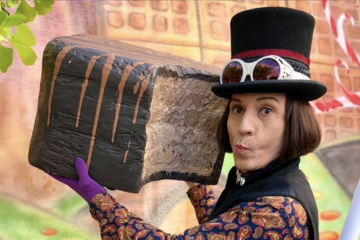20 Years of Madness: A Doc about the TV Show You’d Have Made as a Teen
Guest post by Joseph Bien-Kahn
Twenty-two years ago, in a suburb north of Detroit, four kids sat in front of a green screen on a living room set—beat up couch, green-brown recliner, and a fake plant—to create some sort of unsettling acid trip dubbed the “The Jerry White Jr. Show”. The announcer, a stony teenager in red pants and sunglasses, repeated “It’s the Jerry White Jr. show!” again and again, over 70s late night intro music, while the host and guests rolled around the living room set. Erratic cutting and Wayne’s World-level CGI imbue the whole nonsensical mess with, well, something. Against my better judgment, I could feel the two-minute experience working for me.
“The Jerry White Jr. Show” was one of many skits on 30 Minutes of Madness, the brainchild of White and his group of high school friends, which ran in the middle of the night on Detroit public access in the early 90s. The show was part Tom Green Show and part Jackass, with a touch of the Easy Rider cemetery scene, and a dash of Ed Wood. “I liken it often to a mixtape of bizarre comedy, and inside jokes, and fun things you do to make your friends laugh that surprisingly sometimes can have a life outside of your friend group,” White said.
White told me every once in a while he’d meet someone who recognized him from the show. But mainly, 30 Minutes of Madness did what public access shows do—existed for a small niche of people who happened to be up and watching right at that specific moment and then disappeared.
But last Tuesday, White and director Jeremy Royce released their documentary 20 Years of Madness, which tells the story of White’s return to Michigan twenty years later to make one more episode. The film is an intimate look into the scattered friend group—many of whom struggled (and continue to struggle) with addiction and mental illness—and the challenge of recapturing the spark that made the show work after all these years.
20 Years of Madness – Trailer from 20 Years of Madness on Vimeo.
In a lot of ways, Royce’s adolescence mirrored that of White and his friends. The director left home at 16, moving into his own apartment in Berkeley, California while still in high school. He worked two jobs to support himself, while going to school and having the social life of a teenager, which meant he didn’t allow himself much sleep. “Methamphetamines, to me, was a way to juggle the realities of adulthood as a teenager, in a really irresponsible way,” he said. “It provided an opportunity to do all the things I had to do because of the situation I was in.”
In an essay, “How Filmmaking Saved My Life”, Royce tells the story of how getting a project into a local film festival finally pushed him to quit. “Even though I was a runaway, drug dealer, barely surviving, seeing my work on the big screen gave me a sense of purpose,” he wrote. “I was hooked on something other than speed, but quitting nearly killed me.”
Like White and his friends, Royce existed on the margins. While White took trips to Detroit for shows and raves, Royce went to warehouse parties in West Oakland. Their youths were oddly congruent, 7 years and 2,400 miles apart.
In 2009, when starting at USC film school, Royce moved into a room in an apartment he found on Craigslist. White, who had also been accepted to the program, had moved in the day before. The two instantly clicked and White showed Royce 30 Minutes of Madness within the first week. “At first, I thought, this is kind of ridiculous and poor quality, but there’s something really charming and quirky about it and I love the sensibility,” Royce said. “It’s all these outcasts and weirdos, which I directly related to as somebody who was sort of an outcast in my own right.”
The documentary is framed around White’s return to the Michigan suburb, and his difficult attempt to wrangle his friends into making another episode of the show. The structure is a brilliant one, because it strips much of the rose-colored nostalgia from a possible vanity project—the what-could-have-been is understood through the lens of what actually was. And Royce does not spare White, who is portrayed as a difficult and controlling character.
As I spoke with White about his public access show, it’s clear that he has not fully exorcised the what-could-have-been thinking from his mind. He still believes that if someone from MTV or Comedy Central had gotten a tape or had happened to tune in that 30 Minutes of Madness could have been brought to a national audience. “I think we had all of the elements there, but it didn’t get seen by the right person,” he said. “Or we didn’t push it hard enough. What did I know at age 16, 17, in metro Detroit?”
Royce had more than 300 hours of original 90s footage to work with, because White is a meticulous archivist. He told me that meeting White’s friends during the filming was surreal, because he’d watched them grow and change as teenagers.
His ability to mix clips from the show and behind-the-scenes fun and fights gives the viewer an intimacy with the characters. You watch them learn to be in front of the camera, be annoyed by White’s filming, make each other laugh, and also scream at one another. “It’s a beautiful thing to see this caught-in-amber version of yourself, with all of these delusions of grandeur,” White said.
But then you’re dropped back in, 20 years later, watching them at first awkwardly, and then eagerly, try to recapture something so kinetic and bizarre. The show only ever worked because of the unencumbered looseness that teenagers can have. The group of friends does recapture some of the closeness, and there are many instances of White fighting with his friends the way he did when he was younger. But the most incredible moments come when tightly wound characters—now parents, or schizoaffective carpenters, or struggling artists—are able to tap into the weirdness that defined this highpoint from their youth.
The skits we watch from the new episode are odd and don’t always land. But the success of the show itself is irrelevant to the documentary—though we don’t see it, this is a film about the 20 years between 17 and 37. We see what happens when the “delusions of grandeur” don’t work out, and people are forced to live with compromises. Unfortunately, it’s a relatable story.
“It’s not a film about a TV show, it’s a film about a group of characters that were all struggling with these really crazy demons, and because of those shared demons, they were brought together to make this piece of art,” Royce explained. “They could be a polka band from South America and it would be the same thing.”












